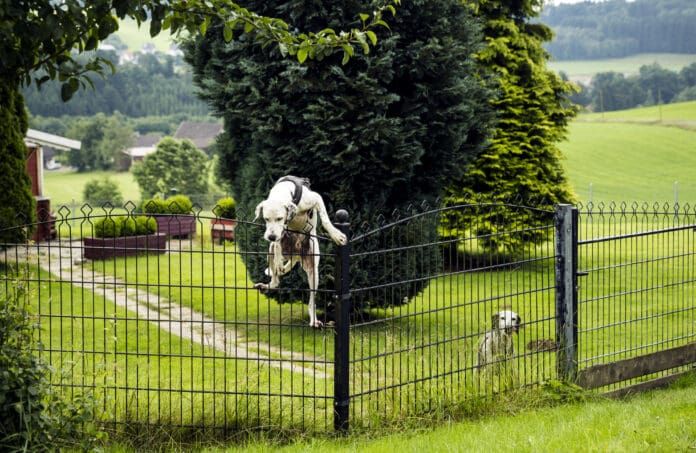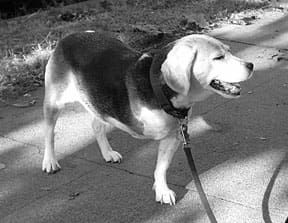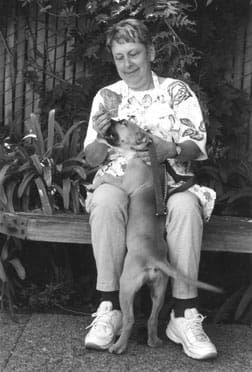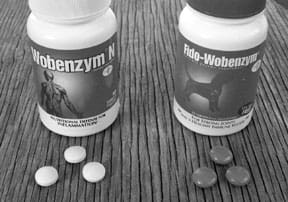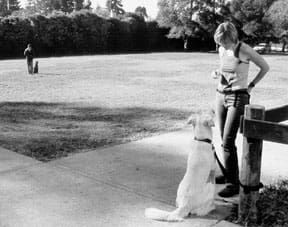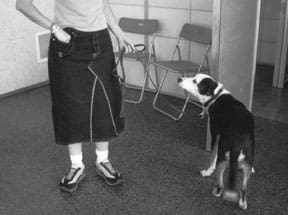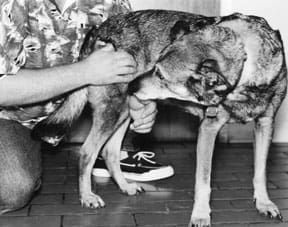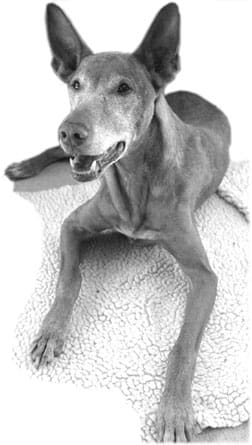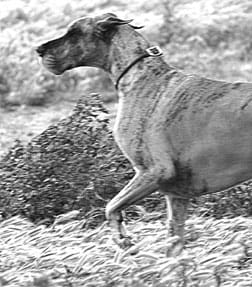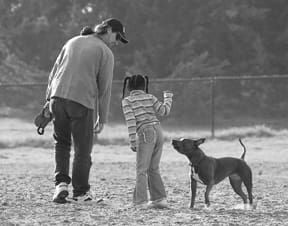
When we decided not to vaccinate Caleb, our Bouvier des Flandres, against anything other than rabies, my friend Janice and I knew we ran a risk that he might develop a dreaded disease. We also knew that vaccination doesn’t always protect against disease, and believed it sometimes causes illness. We felt the home-prepared BARF (bones and raw foods) diet we fed him would help his body fight off many health problems. Naturally, we hoped that Caleb would never come down with anything serious like canine distemper virus (CDV). But, when he was three years old, we had to face and overcome exactly that challenge.
Caleb’s dramatic recovery illustrates the theory that a healthy, well-nourished dog can overcome even a serious disease like CDV – if treated in time by appropriate holistic modalities and devoted home nursing. If we prepare ourselves ahead of time for deadly canine viruses, it can spell the difference between life and death – whether a dog is immunized or not.
The story of how we responded to Caleb’s ailment also illuminates how difficult it can be at times to manage a nonconventional response to your dog’s illness. Many dog owners are accustomed to simply bringing their dogs to their veterinarians, and taking all the vets’ suggestions for treatment. This may be the best approach if an owner has no information about or experience with the dog’s disease; you have to rely on experts you trust!
But in our experience, there are greater rewards for educating yourself before problems happen and working with healthcare experts to corroborate your research and decisions. We feel certain that Caleb would have died if treated with the conventional veterinary tactics for CDV. As I said before, we also felt the risks of vaccination against the disease were not worth the benefits.
Of course, there are risks to this approach as well. Only dog owners who are ready to accept full responsibility for making their own decisions should attempt a nonconventional response like ours.
Telling our distemper story, we hope, will demonstrate the potential risks and huge rewards of implementing a truly holistic healthcare plan for your dog.
Be alert and observant
Janice and I observed the earliest signs of what would prove to be Caleb’s CDV infection about a week before we planned to drive 1,500 miles from rural Ontario to visit a friend in Iowa.
To begin with, Caleb went off his food. Then he threw up and had diarrhea. His first vomit was yellowish and foamy, with what looked like saliva in it. The next few times it contained lots of clear fluid, again with foam on top. His diarrhea was even more unusual. It spurted out – projectile diarrhea. It, too, was yellow, and had a powerful, unusual odor.
At first, we speculated that he had eaten something rotten in our cedar swamp, where he loves to play and explore. When the problem persisted for a day, we discussed it with our veterinarian, Dr. Susan Gambling, who was not unduly alarmed, but advised us to keep watching him and keep her informed. As so often seems to be the case after a call or visit to a vet, the following morning, Caleb started eating again and seemed to have gotten over whatever it was.
Later, I read that the first stage of CDV can be hard to tell from other upsets. Not only that, but it tends to clear up temporarily, making it appear as if the dog is all right.
Four days later, on Monday, we loaded him into our van and left for our vacation. During the two-day drive and the rest of the week, Caleb ate normally. He showed an interest in my friend’s garden, her small Terrier-mix, and her two black cats. But I remained uneasy.
Connect the dots
As the week wore on, Caleb became strangely quiet. Then, on Saturday morning, about 10 days after his original bout of vomiting and diarrhea, his beautiful eyes stayed half shut and oozed green discharge.
Having used homeopathy since 1982, I thought it could help Caleb now. The right remedy must closely match the efforts of the individual’s immune system as revealed by her specific symptoms, regardless of which organisms play into her illness. I thought that the remedy pulsatilla suited Caleb’s discharge and emotional demeanor reasonably well, but the nearest source for the remedy was 50 miles away. We’d have to get it Monday, on our way home.
Then Caleb stopped eating again. By Sunday, he strained to defecate and his energy diminished. We were anxious to get home to Dr. Gambling and the holistic practitioners we sometimes consulted, including Paul McCutcheon, DVM, of East York Animal Clinic in Toronto. At this point, one might argue that we should have taken Caleb straight to the nearest vet. But in this case, as would become clear, the fact that we pushed on until we could reach holistic help almost undoubtedly saved Caleb’s life.
We hit the road for home first thing Monday. Caleb developed a dry, croupy cough and his nose started dripping. The word “distemper” kept coming into my mind as if someone was repeating it to me.
In Iowa City, I called a local vet, and asked whether he thought we should risk the two-day trip home or come for emergency assistance right away. I described Caleb’s symptoms. After he ruled out Parvo and Lyme disease, I asked if this could be distemper. He thought probably not, adding that dogs with distemper generally produce a profuse amount of thick, greenish or yellow discharge from their noses – “Like you’ve never seen before,” he described. “You couldn’t miss it.” He thought we could try to get home to our own vet.
As it turned out, the vet’s remark about identifying CDV by quantity and quality of nasal discharge would become one of two coincidences that contributed to Caleb’s diagnosis and recovery.
The second was that since Caleb was a pup, when reading up on canine diseases something drew me to study everything I could find on distemper in particular. Contrary to mainstream belief, holistic pet care books report hundreds of cures. I did not know then that this curious obsession would someday help to save my dog’s life.
Respond to symptoms
On the road again, mucous started rattling in Caleb’s lungs when he coughed. Green goo still trickled from his eyes, their whites moist and reddish. His breath began to exhibit an odd odor, which would become very strong over the next few days. Having no professional advisor, since pulsatilla still matched some of his symptoms, we bought and gave him some immediately. The potency available, C30, was a reasonable middle strength to try without a homeopath’s guidance.
At our motel that night, Caleb’s cough got worse and he couldn’t get comfortable. We gave him more pulsatilla. We phoned Dr. Gambling at midnight, when she was scheduled to be on call. What alarmed her most was his restlessness. She said if he didn’t settle down within a couple of hours to go to the nearest emergency facility. I found a 24-hour rural vet nearby, and left the yellow pages open with the number handy.
But when we heard thunder, we understood Caleb’s uneasiness. Like many dogs, Caleb becomes agitated hours before an electrical storm. We gave him rock rose, a flower essence remedy, after which he slept quietly. That the storm had caused his anxiety showed us that even when a dog is desperately ill, some symptoms may have unrelated causes.
On Tuesday morning, Caleb’s eyes cleared up completely, as did his cough – a typical positive response to a well-chosen homeopathic remedy. We’d realize later that early homeopathic support may have helped prevent CDV complications of pneumonia, which dogs don’t survive as well as people do, and conjunctivitis. Caleb improved for awhile, but had diarrhea, with straining, later that afternoon. We offered him chicken broth, but he would not drink it.
That night, he threw up thin yellow bile with flecks of bloody mucous. His breath and body smelled caustic and sour, with an almost salty quality. This odor is characteristic of CDV, but I needed my books to remind me of that, and they were at home, still another 350 miles away.
At one point that evening, Caleb rolled onto his back, and we saw that his belly was red and irritated. This would become another clue. Closely related to human red measles, CDV often causes an abdominal rash. But we didn’t yet identify Caleb’s rash since he frequently gets a pink underside when bothered by allergies or fleas. The definitive red spots wouldn’t appear for two more days.
Caleb had diarrhea again on Wednesday morning, although there wasn’t much left in him. Immediately afterward, he seemed weak and wanted to be in the open air.
I phoned our veterinary clinic in Cobourg, Ontario, and made an appointment for 4 p.m. We started the final six hour drive. In spite of our reassuring manner with Caleb, we were shaken and relieved to be nearing home.
Dr. Gambling was off duty, so her associate saw Caleb. He had a fever of 103.6°F. Diarrhea had made his anus sore, his nose dripped, and he was subdued. His urine was dark and greenish; the clinic found albumin in it. But protein breakdown is typical when someone hasn’t eaten for days, so that didn’t tell us much.
It didn’t occur to us then to mention that we hadn’t inoculated Caleb against the usual infections. Dr. Gambling would have known, but she wasn’t there. Maybe we assumed her associates would be aware of Caleb’s history, or perhaps we were too stressed to think clearly. But the missed moment shows that even the experts won’t think of everything! The idea that responsible owners might not have vaccinated may not cross the mind of a vet unfamiliar with holistic thinking. And, these days, due in large part to mass immunization, vets may not see infections like distemper for years. Newer ones may know it only from a textbook.
The vet took blood to send to a lab to look for various possibilities, but did not request a test for CDV. However, even if she had, waiting for a diagnosis would have wasted precious time. CDV advances aggressively, ravaging tissues until it can kill a dog or permanently disrupt its neurological system. The sooner caretakers take action, the better the dog’s chances; not only of survival, but of a good recovery.
Feeling a sense of urgency, we took Caleb home. There, I reread my holistic books about canine viruses, their symptoms, and treatments. By the next day, I’d be glad I’d refreshed myself about what information I had and how to find it fast.
Emotional affects
During the night, Caleb’s breathing became so congested that every inhalation sounded like snoring. At 5 a.m. Thursday, Caleb asked to go out into the darkness of our fenced property. We decided to trust his instinct about what he needed. Maybe the cool autumn air would ease his breathing.
Then, in order to support him best, Janice and I faced our own fears. We felt powerless and scared. But we didn’t want our need to make him well to compromise our ability to help him. Nor did we want him to feel that he must pull through for our sake. And we certainly didn’t want him to redirect his energy into being anxious because we were upset, as dogs will do.
Recognizing this, we resolved to work toward the best possible outcome while acknowledging that it was not ultimately in our hands. If it was his will to survive, we would assist him. If not, we would try to accept that with grace.
At 7 a.m., I found Caleb down near the pond. He wobbled up to meet me and we sat down together on the grass. Then, something astonishing happened. He nodded his head toward me companionably, and a spoonful of creamy yellow liquid gushed out and covered his nose.
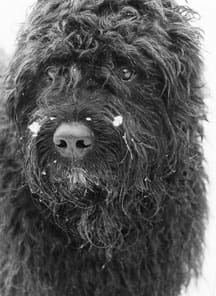
The Iowa vet’s words came back to me. I knew right away that Caleb had distemper. Instead of panic, I felt relief. Now, we knew what was wrong and that something could be done. No need to waste any more time not acting.
Dr. Gambling was on duty that morning. Caleb’s nostrils oozed steadily. His fever was 104°F, and his belly had the measles-like spots. All these signs plus his breath and body odor now clearly indicated stage two of an acute distemper infection, as can hardening of the pads of the feet, which he never developed.
Dr. Gambling took another blood sample, this time for the CDV test. Janice and I said we would take Caleb home and treat him ourselves with natural remedies, and Dr. Gambling got right behind us, acknowledging that such methods would offer Caleb’s best, if not only, hope. “In veterinary school,” she said, “they teach us that when it’s distemper, dogs just . . .” She made the thumbs-down sign to finish her sentence, and added that while conventional medicine can treat CDV, it cannot cure it.
Mainstream response
Medical intervention for CDV generally consists of hospitalizing the dog and intravenously giving fluids, antibiotics, and possibly other drugs or nutrients. This is meant to prevent dehydration, complications like pneumonia, and keep up the dog’s strength. The virus then runs its course.
If the dog survives, she often goes into stage three of the disease, involving encephalitis of the brain or spinal cord. The resulting neurological damage leaves chronic symptoms such as chorea (uncontrollable twitching or jerking) or seizures, during which the dog may cry out. Some vets and dog lovers believe it kinder to put CDV-infected dogs down rather than risk the devastation of stage three.
However, other vets caution against putting CDV dogs on IV fluids. Holistic veterinarian and author Richard Pitcairn, for example, writes that dogs given antibiotics, fluids, and other drugs are more likely to develop stage three than those treated with natural methods. Both Dr. Pitcairn and herbalist Juliette de Bairacli Levy speculate that such measures impede the dog’s ability to throw off the virus. De Bairacli Levy believes that feverish dogs must fast to divert energy from their digestive processes to fight disease.
And Dr. McCutcheon (the holistic vet-erinarian we often consulted via long-distance call) emphasizes that both being kept in hospital away from her family and enduring invasive procedures significantly increases the stress of a dog who is already terribly ill.
Holistic possibilities
As soon as we got Caleb comfortably settled in our house, we turned to our home library and developed a treatment plan from several different sources. The following are the things we read, and how we applied them:
• Vitamin C injections: From How to Have a Healthier Dog, by Wendell O. Belfield, DVM, and Martin Zucker, we learned how Dr. Belfield helped hundreds of dogs with CDV recover by intravenously injecting them with therapeutic doses of vitamin C twice a day for five days. Dr. Belfield recommends the sodium ascorbate form of vitamin C for dogs.
However, sodium ascorbate can be hard to find. We had some in the form of a dietary supplement, but it was not sterile for injections. Dr. Gambling phoned Dr. Belfield, who agreed to ship her some and instruct her how to use it, but delivery from his California clinic would take until Monday to get to us – four dangerously long days away. Instead, we chose to give Caleb vitamin C orally.
• Fasting and medicinal herbs: European herbalist Juliette de Bairacli Levy claims she oversaw at least a thousand cures of CDV with fewer than a dozen cases sustaining neurological damage. (This is described in her book, The Complete Herbal Handbook for the Dog and Cat.) She bases her approach around fasting, and warns that offering food while fever remains above 103°F predisposes a dog toward neurological damage.
In her book, de Bairacli Levy also describes giving dogs with CDV herbal antiseptic tablets or grated raw garlic and honey two to three times per day; honey-water to supply strength; fresh air; short walks for movement of limbs; and a mixture of tree barks to soothe the digestive tract. She also uses an infusion of rosemary, elder flowers, chickweed, speedwell, and/or balm to swab the dog’s eyes and nose, and applies pure almond oil to sore nostrils or eyes. She believes that early treatment will prevent stage three altogether, and advises that owners carefully reintroduce food to a dog after she has been fasting.
Caleb was fasting anyway; we’d withhold food until his temperature was normal for a day. In the meantime, we offered him wild honey water, gave him balls of garlic and honey mash, and bathed his nose and back end with rosemary infusion. As he recovered, we gave him slippery elm powder for his digestive tract. When the time was right, we gave him small amounts of mashed veggies first, easing him gradually back onto meats and his regular supplements.
• Classical homeopathy: In his classic book, Dr. Pitcairn’s Complete Guide to Natural Health for Dogs & Cats, now in its third edition, Richard Pitcairn, DVM, lists six of many possible homeopathic remedies for different stages and symptoms of CDV, advising using a choice of only one. He also suggests dosages of vitamin C as an adjunct.
Having used homeopathy for more than 16 years, I knew it was effective and the remedies were easy to obtain. In this life-and-death situation, we’d want an experienced homeopath to choose the right remedy for Caleb, and we knew Dr. McCutcheon’s clinic would consult long-distance. So, homeopathy would be the hub of our plan. Pitcairn also inspired the dosage of vitamin C we gave Caleb orally: 3,000 mg three times per day.
• Acupuncture: In her book, Keep Your Pet Healthy the Natural Way, Pat Lazarus gathered testimonials from holistic vets who use either vitamin C injections or acupuncture to cure or control effects of stage three of CDV, such as seizures and chorea. Some vets inject vitamin C or B12 into acupuncture points. As it turned out, Caleb did not develop stage three complications. If he had, we would have researched these options further.
Applying the treatment plan
Right after Dr. Gambling confirmed Caleb’s clinical signs of CDV, we phoned Lisa Formosa, DSHomMed, the homeopath who works with Dr. McCutcheon at East York Animal Clinic in Toronto. Formosa took details of Caleb’s physical symptoms, then asked about his emotions and energy level. Was he depressed and flat? Did he want to be left alone? Caleb wasn’t like that. He watched us and acknowledged a greeting when we approached. Although he was physically weak, his energy wasn’t completely diminished.
Based on these and many other factors, Formosa recommended the remedy distemperinum, which is made from the discharge of dogs already sick with the distemper virus. Formosa said if Caleb had been deeply depressed and stage two even more established, she would have chosen homeopathic goldenseal, instead.
I was surprised. Dr. Pitcairn lists both remedies as candidates; yet even as an experienced lay person, I would have chosen goldenseal. Formosa’s explanation about dosage was new to me, too. She said Caleb’s relatively “up” energy level indicated that we start with 30C, because we didn’t want to “overwhelm” him with the higher intensity of 200C. If the lower potency had no effect, then she would recommend trying 200C. This shows why it’s wise, when possible, to get professional advice for serious problems!
We immediately contacted homeopathic pharmacies around the region, and ran into another challenge. They hadn’t even heard of the remedy distemperinum! Fortunately, the East York Animal Clinic kept some in stock. As Caleb had someone responsible at home to watch over him, I jumped in the car and drove the 80 miles to Toronto.
When I got back, I found Caleb resting on his loveseat on the porch and gave him his first dose. It was 6:30 p.m. By 7 p.m., his temperature had dropped to 102.4°F. Then, he howled like usual at a train whistling through the crossing a half mile away! We put chicken broth near him.
Formosa advised us that in classical homeopathy, caretakers administer a dose, then observe. As long as you see improvement, don’t dose again. You repeat the dose when improvement seems to stop. She said Caleb’s nasal discharge might first get worse, and reminded us that homeopathic theory views discharge as a good sign. Then she concluded calmly, “You should be all right.”
Janice and I worked out a schedule specifying what, when, and how much to give of every substance, and posted it on the kitchen cupboard. The final column gave space to check off each task when done. Our intention was to make sure we didn’t miss a beat, especially if we became too anxious to think straight. I started keeping a log on everything that happened. We dosed Caleb twice more that night.
Caleb’s recovery
Caleb came out of his illness as straight as an arrow.
On the second day of treatment, Caleb’s temperature was around 102.4°F. His nasal discharge loosened and flowed easily. On a short walk, he leaped a log (!) and later coughed to clear his lungs. He watched our kitchen activities keenly, and drank a half cup of broth. By mid-afternoon, he rested in his regular lookout spots in the yard, cruised the kitchen counters looking for food, and chased our cat away from his broth.
Once, when looking into his eyes, I sensed his energy drop and gave more distemperinum immediately. He came on strong again and got very hungry. We gave him a few tiny homemade biscuits, as a goodwill gesture. On my bed, he slept happily on his back!
On the third day of treatment, Caleb’s temperature averaged 101.8°. He took some broth with vitamin C and slippery elm in it, plus the honey-garlic mixture. He made a tiny bit of healthy poop. We dosed him again. His nasal discharge was once again clear and colorless.
At one point that day, Caleb caught my eye and placed his foot on the lid of his biscuit tub. When I refused to give him a biscuit, he ran off with my plastic clog. I gave him one small biscuit, and later, some mashed cooked carrot.
We could feel that he was going to be all right.
By day four, Caleb breathed silently through his nose and his rash had faded. As his temperature averaged 101.2°F, over the day we provided cooked grains, a few nuts, baked winter squash with kefir and parsley, another carrot, and grated raw cabbage. (Note: We have long since omitted grain from Caleb’s diet.) He wanted even more.
Things just kept getting better. Caleb’s former sweet breath started returning, and on day five, with his temperature at 100.2°, we offered him his first small portion of raw meat. By the eighth day, all the symptoms of CDV had gone and he was back on his full diet.
To rebuild his health, we added vitamin B complex to his diet, plus oat tincture several weeks later. We kept these up for months, as it takes a long time to rebuild a dog’s strength after CDV.
Finally, we reintroduced his daily supplements slowly as his ravaged digestive system became less sensitive.
When conventionally treated dogs survive CDV, neurological damage can show up weeks or even months later. Dr. Gambling told us that after three symptom-free months, we could announce Caleb’s recovery to the world. It’s now been seven years and counting.
Dr. Gambling also suggested eventually immunizing Caleb against CDV, since her in-office veterinary reference text says survivors maintain natural immunity for, at most, six months. Instead, we agreed to check his titers periodically. A vaccinated dog’s CDV antibody count is normally below 200. The minimum score thought to sustain immunity is 24; after vaccination, it averages 36-48. Caleb’s never-vaccinated titer, more than six years later, is 768.
Today, at 10, Caleb glows with better general health than most dogs his age. He’s a mischievous, shining, energetic testament to why we should feed dogs a natural diet and be well prepared beforehand lest a nasty virus tries to gain a foothold.
-Susan Weinstein is a freelance writer with a strong interest in animals and holistic healthcare. She is now working on a book about pets and stress with Paul McCutcheon, DVM. Weinstein and Caleb live with Janice Newson and Farida the Monster Cat in Grafton, Ontario.




